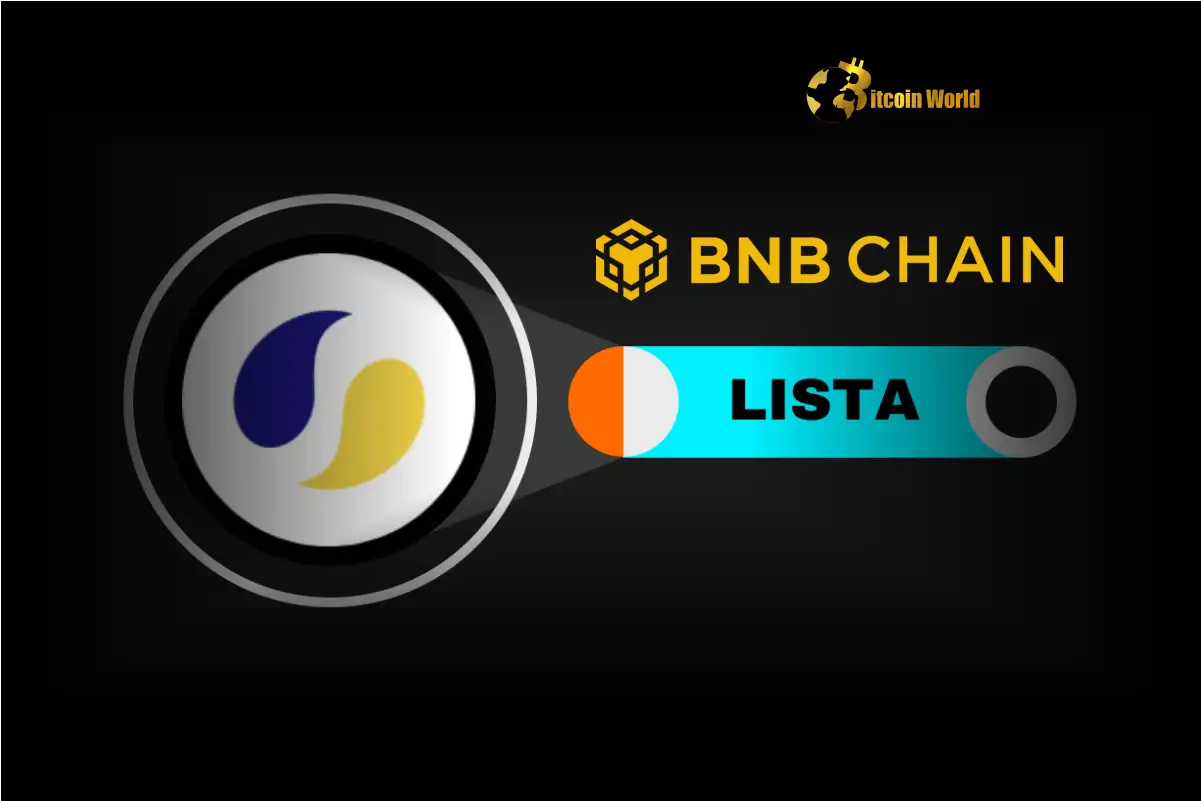Revolutionary Peer-to-Peer Lending: Lista DAO Unveils Groundbreaking Protocol on BNB Chain
0
0

Exciting news for the decentralized finance (DeFi) space! Lista DAO, known for its lisUSD stablecoin, has just dropped a game-changer – Lista Lending. This brand-new peer-to-peer lending protocol is set to revolutionize how users interact with DeFi on the BNB Chain. Are you ready to explore how this innovative platform can potentially reshape your crypto lending experience?
What is Lista DAO and Lista Lending?
First things first, let’s understand the players. Lista DAO is the organization behind lisUSD, a stablecoin designed to maintain its peg to the US dollar. They are committed to expanding the utility and reach of lisUSD within the DeFi ecosystem. Now, stepping into the spotlight is Lista Lending, their latest creation. Announced on their official Medium page, this protocol is specifically designed to facilitate peer-to-peer lending directly on the BNB Chain.
But what exactly does this mean for you?
- Enhanced lisUSD Utility: Lista Lending is strategically built to increase the demand and usage of lisUSD. By providing a robust lending and borrowing platform, it creates more avenues for users to engage with the stablecoin.
- Decentralized Lending Infrastructure: The core aim is to build a more efficient, transparent, and decentralized lending environment. This aligns with the fundamental principles of DeFi, moving away from traditional, centralized financial systems.
- BNB Chain Focus: By launching on BNB Chain, Lista DAO is tapping into a vibrant and active blockchain ecosystem, known for its speed and lower transaction costs compared to some other networks.
In essence, Lista Lending is not just another lending platform; it’s a strategic move by Lista DAO to solidify its position in the DeFi space and empower users with more control over their assets within a decentralized framework.
Why Peer-to-Peer Lending on BNB Chain is a Game Changer?
Peer-to-peer lending, often abbreviated as P2P lending, cuts out the middleman – traditional financial institutions. Instead of borrowing from a bank, you borrow directly from another individual or entity through a platform like Lista Lending. This model offers several potential advantages, especially within the DeFi context on BNB Chain:
| Feature | Traditional Lending | Peer-to-Peer Lending (Lista Lending) |
|---|---|---|
| Intermediary | Banks, Financial Institutions | Decentralized Protocol (Smart Contracts) |
| Transparency | Often Opaque, Limited Visibility | Highly Transparent, On-Chain Transactions |
| Efficiency | Potentially Slower, Bureaucratic Processes | Faster, Automated Processes via Smart Contracts |
| Accessibility | May Have Strict Requirements, Limited Access for Some | Potentially More Accessible, Lower Barriers to Entry |
| Control | Less Control Over Terms and Conditions | Potentially More Control, Negotiable Terms within Protocol Parameters |
BNB Chain further enhances the appeal of peer-to-peer lending due to its characteristics:
- Lower Fees: Transaction fees on BNB Chain are generally lower than on networks like Ethereum, making it more cost-effective for frequent lending and borrowing activities.
- Faster Transactions: BNB Chain boasts faster transaction speeds, ensuring quicker loan processing and fund transfers within Lista Lending.
- Growing Ecosystem: The BNB Chain ecosystem is continuously expanding, with a large user base and a wide array of DeFi projects, creating a fertile ground for Lista Lending to thrive.
By combining the benefits of peer-to-peer lending with the advantages of BNB Chain, Lista DAO is positioning Lista Lending as a compelling alternative within the DeFi lending landscape.
Diving Deeper: How Does DeFi Lending with Lista Lending Actually Work?
While the specifics of the Lista Lending protocol will be detailed in their official documentation, we can infer some general mechanisms based on common DeFi lending protocols and the principles of peer-to-peer lending. Here’s a simplified breakdown:
- Liquidity Pools: Likely, Lista Lending will utilize liquidity pools. Users can deposit their crypto assets (potentially including lisUSD and other tokens supported on BNB Chain) into these pools to provide liquidity. These depositors become lenders, earning interest on their deposited assets.
- Borrowing: Borrowers can then access these liquidity pools to take out loans. To borrow, users typically need to provide collateral, which is usually in the form of other crypto assets. The collateral acts as security for the loan, protecting lenders in case borrowers default.
- Interest Rates: Interest rates in DeFi lending protocols are often algorithmically determined based on supply and demand. When demand for borrowing is high, interest rates tend to increase, and vice versa. This dynamic mechanism aims to balance the interests of both lenders and borrowers.
- Smart Contracts: The entire process is governed by smart contracts. These self-executing contracts automatically manage loan terms, collateral, interest accrual, and repayment, ensuring transparency and reducing the need for intermediaries.
- Risk Management: Protocols like Lista Lending incorporate risk management mechanisms, such as liquidation thresholds. If the value of a borrower’s collateral falls below a certain level, the collateral may be automatically liquidated to repay the loan and protect lenders.
It’s important to remember that DeFi lending, while offering exciting opportunities, also carries risks. Users should thoroughly understand the protocol’s mechanics, risk parameters, and the assets they are interacting with before participating.
Unlocking the Potential of lisUSD Utility through Peer-to-Peer Lending
A key driver behind Lista Lending is to significantly enhance the utility of lisUSD. How does peer-to-peer lending achieve this for the lisUSD stablecoin?
- Increased Demand: By making lisUSD a core asset within the lending protocol, Lista Lending naturally increases the demand for the stablecoin. Users who want to participate as lenders or borrowers within the platform might need to acquire lisUSD.
- Greater Circulation: As lisUSD is used for lending and borrowing activities, it circulates more actively within the DeFi ecosystem. This increased circulation can lead to wider adoption and recognition of lisUSD.
- Yield Opportunities: Lista Lending provides opportunities for lisUSD holders to earn yield by depositing their stablecoins into liquidity pools. This yield generation can be an attractive incentive for holding and utilizing lisUSD.
- Ecosystem Integration: The success of Lista Lending can further integrate lisUSD into the broader BNB Chain ecosystem. As more users and projects interact with lisUSD through lending and borrowing, its importance and relevance within the ecosystem grow.
In essence, Lista Lending acts as a powerful catalyst for lisUSD, transforming it from just a stablecoin into a more actively utilized and integral component of the DeFi landscape on BNB Chain.
What are the Benefits of Embracing Lista Lending?
For users considering engaging with Lista Lending, what are the potential advantages? Here’s a breakdown of key benefits:
- Earn Yield on Your Crypto: Lenders can deposit their assets, including lisUSD, and earn passive income through interest accrued from borrowers. This can be a compelling way to grow your crypto holdings.
- Access Liquidity Without Selling: Borrowers can access liquidity by taking out loans against their crypto collateral without having to sell their assets. This is particularly useful for users who want to maintain their long-term crypto positions while accessing funds.
- Transparent and Decentralized: Lista Lending operates on the principles of DeFi, offering transparency and decentralization. All transactions and protocol rules are auditable on the blockchain, and there’s no central authority controlling the platform.
- Potentially Competitive Rates: Peer-to-peer lending platforms can offer competitive interest rates for both lenders and borrowers compared to traditional financial systems. Rates are often determined by market dynamics, potentially leading to more favorable terms.
- Financial Inclusion: DeFi platforms like Lista Lending have the potential to enhance financial inclusion by providing access to lending and borrowing services to a wider range of users, regardless of their location or credit history.
However, it’s crucial to remember that these benefits come with associated risks, which we’ll explore next.
Navigating the Challenges and Considerations of DeFi Lending
While DeFi lending platforms like Lista Lending offer exciting opportunities, it’s essential to be aware of the inherent challenges and considerations:
- Smart Contract Risks: DeFi lending protocols rely on smart contracts, which, while generally secure, are still susceptible to bugs or vulnerabilities. A flaw in the smart contract code could potentially lead to loss of funds.
- Volatility Risk: The value of crypto assets, especially those used as collateral, can be highly volatile. Sudden price drops can trigger liquidations, potentially resulting in losses for borrowers.
- Liquidation Risk: As mentioned earlier, liquidation is a mechanism to protect lenders, but it poses a risk to borrowers. If the value of your collateral falls below the liquidation threshold, your assets could be automatically sold at potentially unfavorable prices.
- Regulatory Uncertainty: The regulatory landscape for DeFi is still evolving. Changes in regulations could potentially impact the operation and legality of DeFi lending platforms.
- Complexity: DeFi lending can be complex, especially for newcomers to the crypto space. Understanding the mechanics of liquidity pools, collateralization, and liquidation risks requires effort and due diligence.
Before participating in Lista Lending or any DeFi lending platform, it’s vital to conduct thorough research, understand the risks involved, and only invest what you can afford to lose. Start with smaller amounts and gradually increase your participation as you become more comfortable with the platform and the associated risks.
Conclusion: A Promising Step Forward for DeFi on BNB Chain
Lista DAO’s launch of Lista Lending on BNB Chain marks a significant step forward for the DeFi ecosystem. By introducing a peer-to-peer lending protocol focused on enhancing lisUSD utility, they are contributing to a more robust and versatile decentralized financial landscape. The potential benefits for users are clear: opportunities to earn yield, access liquidity, and engage in transparent and decentralized financial activities. While challenges and risks remain inherent in the DeFi space, platforms like Lista Lending are pushing the boundaries of financial innovation and offering compelling alternatives to traditional systems.
As the DeFi space continues to evolve, keep a close eye on developments like Lista Lending. Understanding these innovations and engaging responsibly can open up new avenues within the exciting world of decentralized finance. Will Lista Lending truly revolutionize peer-to-peer lending on BNB Chain? Only time will tell, but the initial signs are certainly promising!
To learn more about the latest crypto market trends, explore our article on key developments shaping Ethereum price action.
0
0
 Manage all your crypto, NFT and DeFi from one place
Manage all your crypto, NFT and DeFi from one placeSecurely connect the portfolio you’re using to start.




